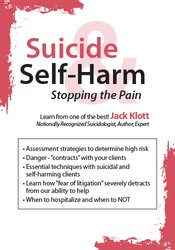

Your client just revealed that she’s having suicidal thoughts...what do you do?
Does she have a gun? Has she written letters? Picked a location? Have hope something will change and doesn’t want to hurt family and friends?
Asking your client, “where do you hurt?” often reveals the focus of the suicidal intent or the purpose of self-harm behaviors. As a clinician, it’s important to remember that even though you view suicide and self-harm behaviors as dysfunctional and maladaptive, your client views them as purpose-driven means of eliminating or managing unbearable levels of pain. For your client, these behaviors are beneficial, attractive, and helpful.
Even the most seasoned therapists struggle to develop an empathic view of their client’s devastating methods of managing emotional pain. Learning how to help clients discover the sources of their pain and providing them with healthy options for solving and managing these struggles in their lives is the key to hope.
Through case studies observed in his 45 years as a counselor and suicidologist, Jack Klott brings to life the ideas, theories and concepts you need to help your clients:
Watch Jack and learn how to help your clients confront the darkness of suicide and self-harm behaviors.
This online program is worth 6.25 hours CPD.
| File type | File name | Number of pages | |
|---|---|---|---|
| Manual - Suicide & Self-Harm (0.70 MB) | 28 Pages | Available after Purchase | |
| Manual - Suicide & Self-Harm - French (0.70 MB) | 28 Pages | Available after Purchase | |
| Manual - Suicide & Self-Harm - Italian (0.70 MB) | 28 Pages | Available after Purchase |
Jack Klott, MSSA, LCSW, CSWW, Suicidologist, and national speaker has helped and educated tens of thousands in his 45 years of suicide and self-harm client work. Jack is a 35-year member of the American Association of Suicidology and was a founder of the Michigan Association of Suicidology (where he has been recognized for his contribution to suicide prevention in Michigan).
He authored the national best sellers The Suicide and Homicide Risk Assessment and Prevention Treatment Planner (Wiley, 2004), The Co-Occurring Disorders Treatment Planner (Wiley, 2006), and Suicide and Psychological Pain: Prevention That Works (PESI, 2012).
Jack is a popular and sought after seminar speaker on suicide prevention, motivational interviewing, co-occurring disorders and the DSM®. Attendees rave about his unique teaching gift of weaving expertise, passion and compassion into practical, understandable and usable information.
Speaker Disclosures:
| 5 |
|
| 4 |
|
| 3 |
|
| 2 |
|
| 1 |
|
Satisfaction Guarantee
Your satisfaction is our goal and our guarantee. Concerns should be addressed to info@pesi.co.uk or call 01235847393.
Please wait ...